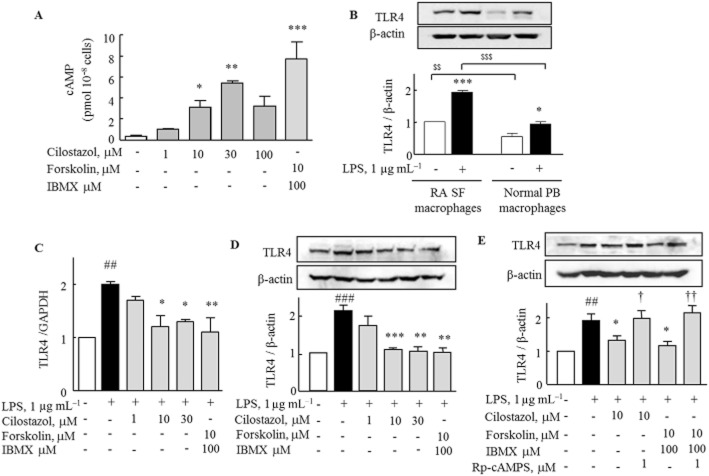Figure 1.
Inhibitory effects of cilostazol and forskolin/IBMX on LPS-induced TLR4 mRNA and protein expression in RA macrophages. (A) Intracellular cAMP level in RA macrophages after treatment with cilostazol (1–100 μM) or forskolin (10 μM) + IBMX (100 μM) for 1 h was measured by elisa. Results are expressed as the mean ± SEM (n = 4). *P < 0.05, **P < 0.01, ***P < 0.001 versus no treatment. (B) Comparison of TLR4 protein expression in the absence and the presence of LPS for 24 h between synovial fluid (SF) macrophages and peripheral blood (PB) macrophages from each five donors. Results are expressed as the mean ± SEM (n = 5). $$P < 0.01, $$$P < 0.001 versus no treatment. (C and D) Cilostazol and forskolin/IBMX induced decrease in TLR4 mRNA and protein, as revealed by real-time PCR and Western blot. RA macrophages were treated with cilostazol (1, 10, 30 μM) and forskolin (10 μM) + IBMX (100 μM) for 4 h, followed by exposure to LPS for 12 h (real-time PCR) and 24 h (Western blot). (E) Reversal by Rp-cAMPS of decreased TLR4 protein expression by cilostazol and forskolin + IBMX. Rp-cAMPS (1 μM) was applied at 30 min prior to treatment with cilostazol. Results are expressed as the mean ± SEM (n = 4–5). ##P < 0.01, ###P < 0.001 versus no treatment; *P < 0.05, **P < 0.01, ***P < 0.001 versus LPS alone; †P < 0.05, ††P < 0.01 significant effect of Rp-cAMPS.

